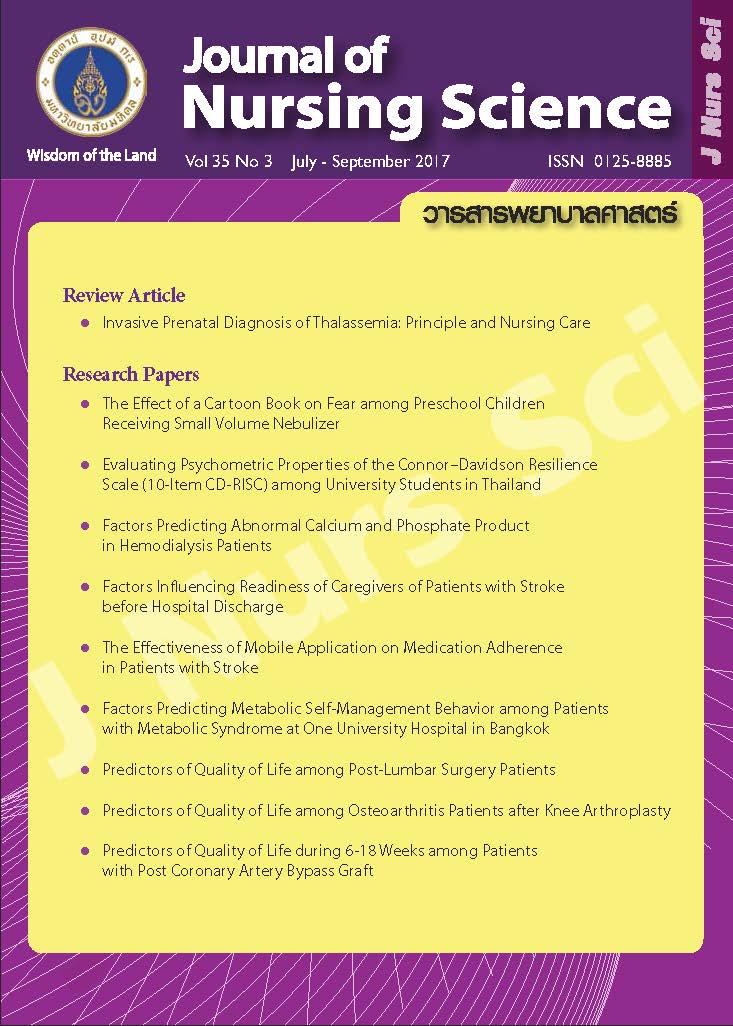The Effectiveness of Mobile Application on Medication Adherence in Patients with Stroke ประสิทธิผลของโมบายแอพพลิเคชั่นต่อความร่วมมือในการรับประทานยาในผู้ป่วยโรคหลอดเลือดสมอง
Main Article Content
Abstract
Purpose: To study the effects of a mobile application on medication adherence in stroke patients.
Design: Experimental study.
Method: The samples of this study were 56 patients with stroke, aged 18 years and above who followed up at one University Hospital in Bangkok. Block random assignment was used to assign the sample into the experimental group (N = 28) and the control group (N = 28). The experimental group received regular nursing care, the medication handbook for patients with stroke and was given the mobile application with reminder, medication information, stroke symptoms, medication taken record system and interconnection data system with the researcher. The control group received regular nursing care and the medication handbook for patients with stroke. Data were collected using personal data questionnaire and medication adherence report scale (MARS5) which obtained Cronbach’s Alpha Coefficient at .81 and were analyzed by Mann-Whitney U Test.
Main finding: The result revealed that medication adherence among the experimental group was statistically significant higher than the control group (p < .05). Mobile application can improve patient adherence to medication 42.85%.
Conclusion and recommendations: The finding of this study confirms the effectiveness of mobile application to increase medication adherence in stroke patients. The mobile application should be further developed in other operating systems to be more appropriately used by stroke patients.
บทคัดย่อ
วัตถุประสงค์: เพื่อศึกษาผลของโมบายแอพพลิเคชั่นต่อความร่วมมือในการรับประทานยา ระหว่างผู้ป่วยโรคหลอดเลือดสมองที่ได้รับโมบายแอพพลิเคชั่น และผู้ป่วยที่ได้รับการดูแลตามปกติ
รูปแบบการวิจัย: การวิจัยเชิงทดลอง
วิธีดำเนินการวิจัย: การวิจัยครั้งนี้เป็นการวิจัยเชิงทดลอง เพื่อศึกษาประสิทธิผลของโมบายแอพพลิเคชั่นต่อความร่วมมือในการรับประทานยาในผู้ป่วยโรคหลอดเลือดสมอง อายุ 18 ปีขึ้นไป จำนวน 56 คน ที่รับการรักษาที่แผนกผู้ป่วยนอก โรงพยาบาลมหาวิทยาลัยแห่งหนึ่งในกรุงเทพมหานคร แบ่งเป็นกลุ่มควบคุมและกลุ่มทดลองด้วยการสุ่มแบบบล็อก กลุ่มละ 28 คน กลุ่มทดลองได้รับการดูแลแบบปกติ ได้รับคู่มือการรับประทานยาสำหรับผู้ป่วยโรคหลอดเลือดสมอง และได้รับโมบายแอพพลิเคชั่นติดตั้งบนสมาร์ทโฟน ประกอบด้วย การเตือนรับประทานยาและนัดหมาย ฐานข้อมูลยา อาการของโรคหลอดเลือดสมอง ระบบบันทึกการสถิติรับประทานยา และการเชื่อมต่อข้อมูลกับผู้วิจัย กลุ่มควบคุมได้รับการดูแลแบบปกติ และได้รับคู่มือการรับประทานยาสำหรับผู้ป่วยโรคหลอดเลือดสมอง ใช้ระยะเวลาการทดลอง 4 สัปดาห์ เก็บข้อมูลโดยใช้แบบสอบถามข้อมูลส่วนบุคคล และแบบสอบถามความร่วมมือในการรับประทานยา มีค่าสัมประสิทธิ์แอลฟาของครอนบาค เท่ากับ .81 วิเคราะห์ข้อมูลโดยใช้สถิติแมน-วิทนีย์ ยู
ผลการวิจัย: ภายหลังการทดลองคะแนนความร่วมมือในการรับประทานยาของผู้ป่วยโรคหลอดเลือดสมองที่ได้รับโมบายแอพพลิเคชั่น มากกว่ากลุ่มที่ควบคุมอย่างมีนัยสำคัญทางสถิติ (p < .05) และพบว่าผู้ป่วยในกลุ่มทดลองมีความร่วมมือในการรับประทานยาเพิ่มขึ้นร้อยละ 42.86
สรุปและข้อเสนอแนะ: ผลการศึกษาครั้งนี้ยืนยันถึงประสิทธิผลของโมบายแอพพลิเคชั่นในการเพิ่มความร่วมมือในการรับประทานยาในผู้ป่วยโรคหลอดเลือดสมอง ควรมีพัฒนาโมบายแอพพลิเคชั่นต่อไปโดยใช้ในระบบปฏิบัติการอื่นๆ เพื่อให้มีความเหมาะสมต่อการการนำไปใช้โดยผู้ป่วยโรคหลอดเลือดสมองมากขึ้น
Article Details
Copyright Notice: Nursing Science Journal of Thailand has exclusive rights to publish and distribute the manuscript and all contents therein. Without the journal’s permission, the dissemination of the manuscript in another journal or online, and the reproduction of the manuscript for non-educational purpose are prohibited.

Disclaimer: The opinion expressed and figures provided in this journal, NSJT, are the sole responsibility of the authors. The editorial board bears no responsibility in this regard.
References
2. Kochanek KD, Murphy SL, Xu J, Arias E. Mortality in the United States, 2013. NCHS Data Brief. 2014;(178):1-8.
3. Mozaffarian D, Benjamin EJ, Go AS, Arnett DK, Blaha MJ, Cushman M, et al. Executive summary: heart disease and stroke statistics-2015 update: a report from the American Heart Association. Circulation. 2015;131(4):434-41.
4. Bureau of Policy and Strategy, Office of the Permanent Secretary, Ministry of Public Health. Public health statistics A.D. 2014 [Internet]. Nonthaburi: Bureau of Policy and Strategy; 2014 [Cited 2016 Jun 16]. Available from: http://bps.moph.go.th/new_bps/sites/default/files/health_statistics2557.pdf. (in Thai).
5. O’Carroll R, Whittaker J, Hamilton B, Johnston M, Sudlow C, Dennis M. Predictors of adherence to secondary preventive medication in stroke patients. Ann Behav Med. 2011;41(3):383-90.
6. Hackam DG, Spence JD. Combining multiple approaches for the secondary prevention of vascular events after stroke: a quantitative modeling study. Stroke. 2007;38(6):1881-5.
7. Bushnell CD, Olson DM, Zhao X, Pan W, Zimmer LO, Goldstein LB, et al. Secondary preventive medication persistence and adherence 1 year after stroke. Neurology. 2011;77(12):1182-90.
8. Sadoyoo S, Jirapreeya N, Treesak C, Sangjam P. Leftover medications in patients with chronic diseases from home health care visits: a community study in Bangkok. Dialogue on Pharmacy and Health Care Practice. 2014;1(1):1-7. (in Thai).
9. Kronish IM, Diefenbach MA, Edmondson DE, Phillips LA, Fei K, Horowitz CR. Key barriers to medication adherence in survivors of strokes and transient ischemic attacks. J Gen Intern Med. 2013;28(5):675-82.
10. Jones KR, Lekhak N, Kaewluang N. Using mobile phones and short message service to deliver self-management interventions for chronic conditions: a met-areview. Worldviews Evid Based Nurs. 2014;11(2):81-8.
11. Patel S, Jacobus-Kantor L, Marshall L, Ritchie C, Kaplinski M, Khurana PS, et al. Mobilizing your medications: an automated medication reminder application for mobile phones and hypertension medication adherence in a high-risk urban population. J Diabetes Sci Technol. 2013;7(3):630-9.
12. Fisher JD, Fisher AW. Changing AIDS-risk behavior. Psychol Bull. 1992;111(3):455-74.
13. Horne R, Weinman J, Barber N, Elliott R, Morgan M, Cribb A, et al. Concordance, adherence and compliance in medicine taking. London, UK: National Co-ordinating Centre for NHS Service Delivery and Organization R and D; 2005. p.1–309.
14. Rujisatian N. The relationship of illness representations and beliefs about medications to adherence to oral hypoglycemic medications in persons with type 2 diabetes [master’s thesis]. Bangkok: Mahidol University; 2009. 137 p. (in Thai).
15. Mira JJ, Navarro I, Botella F, Borrás F, Nuño-Solinís R, Orozco D, Iglesias-Alonso F, et al. A Spanish pillbox app for elderly patients taking multiple medications: randomized controlled trial. J Med Internet Res. 2014;16(4):e99.
16. Klein M, Mogles N, van Wissen A. Intelligent mobile support for therapy adherence and behavior change. J Biomed inform. 2014;51:137-51.
17. Athilingam P, Labrador MA, Remo EF, Mack L, San Juan AB, Elliott AF. Features and usability assessment of a patient-centered mobile application (HeartMapp) for self-management of heart failure. Appl Nurs Res. 2016;32:156-63.
18. Perera AI, Thomas MG, Moore JO, Faasse K, Petrie KJ. Effect of a smartphone application incorporating personalized health-related imagery on adherence to antiretroviral therapy: a randomized clinical trial. AIDS Patient Care STDS. 2014;28(11):579-86.


